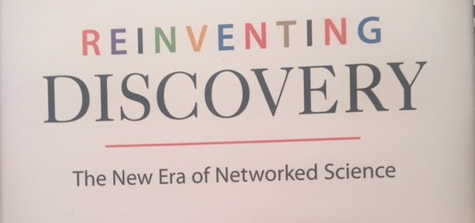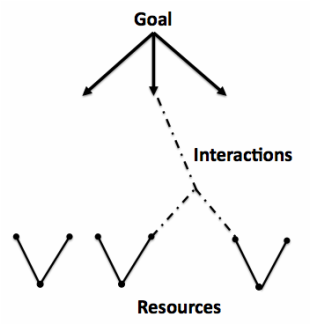In Michael Nielsen's book, Reinventing Discovery, he performed an extensive survey of attempts to amplify collective intelligence and then presented four principles that any group process should possess. BrainSwarming meets all these requirements; brainstorming does not satisfy any of them.
(1) A rich and well structured set of information common to the group that people can easily build upon.
The BrainSwarming graph presents the commonly available information that people can easily build upon. With brainstorming, you need to remember what people say and a textual summary is sent around after the session is over--which is too late.
(2) Microcontributions (i.e., small contributions).
Contributions should be brief so they can be read quickly and a new person can easily "get up to speed" on the status of the problem. BrainSwarming in-person uses Post-Its upon which only a small amount of text can fit--much as Twitter's 140 character limit forces brevity and encourages self-editing. BrainSwarming online only accepts short phrases. With brainstorming, people can talk for long periods of time unless controlled by a facilitator. The silence and written Post-Its of BrainSwarming keep the talkative people under control with no need for a facilitator.
(3) High Degree of Modularity (i.e., break problem into very small parts)
Contributions should represent very small parts of the problem. The BrainSwarming graph divides problem solving into its natural joints of small parts of the problem. A contribution is either a goal, sub-goal, a resource, a part of a resource, a feature of a resource, or an effect achieved by interacting resources. With brainstorming, there is no structure to a person's contribution so people tend to share complete solutions or nearly-complete solutions. However, a complete solution hides many alternative solutions that should be articulated.
For example, in the Harvard Business Review video on BrainSwarming, someone might want to solve the problem "remove ice from power lines" by "shake the power lines with a long pole."
http://blogs.hbr.org/2014/03/why-you-should-stop-brainstorming/
BrainSwarming would divide this solution into small components (i.e., "shake the power lines," "long pole," and a line connecting the two indicating that the long pole can be used to shake the lines). These small components on the graph make it clear that many possible alternative solutions exist. For example, entering "shake the power lines" as a sub-goal makes it clear that there are many ways to induce shaking: strong controlled wind from a helicopter, blast of sound from a sonic gun, a small robot that crawls across the lines, etc.
(4) An architecture of attention (i.e., get people with the right expertise to the right part of the problem).
In the online version of BrainSwarming, users register their areas of interest and expertise. The software guides users to parts of the graph that match each individual's interest and expertise. With brainstorming (even electronic brainstorming), this requirement is usually not considered.
(1) A rich and well structured set of information common to the group that people can easily build upon.
The BrainSwarming graph presents the commonly available information that people can easily build upon. With brainstorming, you need to remember what people say and a textual summary is sent around after the session is over--which is too late.
(2) Microcontributions (i.e., small contributions).
Contributions should be brief so they can be read quickly and a new person can easily "get up to speed" on the status of the problem. BrainSwarming in-person uses Post-Its upon which only a small amount of text can fit--much as Twitter's 140 character limit forces brevity and encourages self-editing. BrainSwarming online only accepts short phrases. With brainstorming, people can talk for long periods of time unless controlled by a facilitator. The silence and written Post-Its of BrainSwarming keep the talkative people under control with no need for a facilitator.
(3) High Degree of Modularity (i.e., break problem into very small parts)
Contributions should represent very small parts of the problem. The BrainSwarming graph divides problem solving into its natural joints of small parts of the problem. A contribution is either a goal, sub-goal, a resource, a part of a resource, a feature of a resource, or an effect achieved by interacting resources. With brainstorming, there is no structure to a person's contribution so people tend to share complete solutions or nearly-complete solutions. However, a complete solution hides many alternative solutions that should be articulated.
For example, in the Harvard Business Review video on BrainSwarming, someone might want to solve the problem "remove ice from power lines" by "shake the power lines with a long pole."
http://blogs.hbr.org/2014/03/why-you-should-stop-brainstorming/
BrainSwarming would divide this solution into small components (i.e., "shake the power lines," "long pole," and a line connecting the two indicating that the long pole can be used to shake the lines). These small components on the graph make it clear that many possible alternative solutions exist. For example, entering "shake the power lines" as a sub-goal makes it clear that there are many ways to induce shaking: strong controlled wind from a helicopter, blast of sound from a sonic gun, a small robot that crawls across the lines, etc.
(4) An architecture of attention (i.e., get people with the right expertise to the right part of the problem).
In the online version of BrainSwarming, users register their areas of interest and expertise. The software guides users to parts of the graph that match each individual's interest and expertise. With brainstorming (even electronic brainstorming), this requirement is usually not considered.


 RSS Feed
RSS Feed
